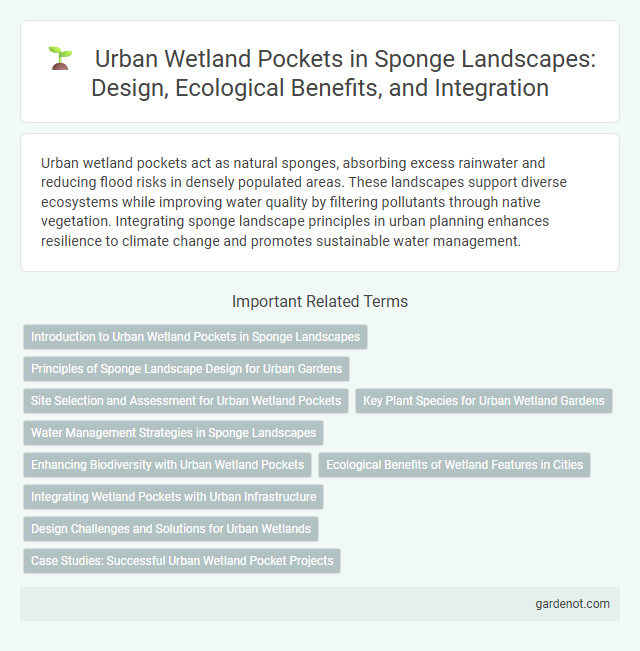Urban wetland pockets act as natural sponges, absorbing excess rainwater and reducing flood risks in densely populated areas. These landscapes support diverse ecosystems while improving water quality by filtering pollutants through native vegetation. Integrating sponge landscape principles in urban planning enhances resilience to climate change and promotes sustainable water management.
Introduction to Urban Wetland Pockets in Sponge Landscapes
Urban wetland pockets within sponge landscapes serve as crucial natural infrastructures that absorb, store, and filter stormwater, reducing urban flooding and improving water quality. These small-scale wetlands support biodiversity by providing habitat for various plant and animal species while enhancing microclimates in densely built areas. Incorporating urban wetland pockets in city planning promotes sustainable water management and resilience against climate change impacts.
Principles of Sponge Landscape Design for Urban Gardens
Urban wetland pockets exemplify sponge landscape principles by integrating natural water retention and filtration systems within compact garden spaces, promoting biodiversity and flood mitigation. Design strategies emphasize permeable surfaces, native aquatic plants, and layered soil profiles to enhance rainwater absorption and gradual release. Incorporating these elements transforms urban gardens into resilient ecosystems that manage stormwater sustainably while supporting local wildlife habitats.
Site Selection and Assessment for Urban Wetland Pockets
Site selection for urban wetland pockets prioritizes areas with natural hydrological connectivity and existing water flow patterns to maximize stormwater retention and biodiversity benefits. Assessment involves evaluating soil permeability, local vegetation, and surrounding land use to ensure ecological compatibility and pollution mitigation. Integrating GIS mapping and field surveys enhances precision in identifying optimal locations for restoring or constructing wetland habitats within urban landscapes.
Key Plant Species for Urban Wetland Gardens
Key plant species for urban wetland gardens in sponge landscapes include native sedges like Carex spp., which enhance water filtration and provide habitat for local wildlife. Cattails (Typha latifolia) play a vital role in stabilizing soil and improving water retention, supporting the ecological functions of urban wetlands. Incorporating diverse wetland shrubs such as Salix spp. boosts biodiversity and strengthens the resilience of sponge landscapes in urban environments.
Water Management Strategies in Sponge Landscapes
Urban wetland pockets play a crucial role in sponge landscapes by enhancing water management through natural filtration and flood mitigation. These ecosystems absorb excess rainwater, reducing urban runoff and preventing waterlogging during heavy precipitation events. Integrating urban wetland pockets into city planning supports groundwater recharge, improves water quality, and promotes biodiversity in densely populated areas.
Enhancing Biodiversity with Urban Wetland Pockets
Urban wetland pockets serve as vital habitats that significantly enhance biodiversity by providing refuge for native flora and fauna within city environments. These ecosystems support diverse species, including amphibians, birds, and aquatic plants, contributing to ecological balance and improving urban resilience. Integrating urban wetland pockets into city planning promotes biological corridors and maintains natural water cycles, fostering sustainable urban biodiversity.
Ecological Benefits of Wetland Features in Cities
Urban wetland pockets act as natural sponges, filtering pollutants and improving water quality by trapping sediments and absorbing excess nutrients. These wetlands support biodiversity, providing habitat for various bird species, amphibians, and insects within city landscapes. Their presence reduces urban flooding by absorbing stormwater runoff, mitigating the impacts of heavy rains and enhancing groundwater recharge.
Integrating Wetland Pockets with Urban Infrastructure
Integrating wetland pockets with urban infrastructure enhances stormwater management by naturally filtering pollutants and reducing runoff. These urban wetland pockets function as critical green buffers, improving biodiversity and providing recreational spaces within city landscapes. Strategic placement alongside roads, parks, and residential areas ensures seamless connectivity and maximizes ecological and social benefits.
Design Challenges and Solutions for Urban Wetlands
Urban wetland pocket design faces challenges including limited space, pollution, and water retention difficulties within dense cityscapes. Integrating permeable surfaces, native vegetation, and biofiltration systems enhances water quality and supports biodiversity while managing stormwater effectively. Employing modular, adaptive design frameworks addresses fluctuating urban demands and maximizes ecological benefits of urban wetland pockets.
Case Studies: Successful Urban Wetland Pocket Projects
Urban wetland pocket projects in cities like Beijing's Sponge City initiative have demonstrated significant improvements in stormwater management and biodiversity enhancement. The Cheonggyecheon Stream restoration in Seoul exemplifies effective urban wetland pocket integration by reducing flood risks and creating recreational green spaces. These case studies highlight how urban wetlands serve as crucial ecological infrastructure, improving water quality and urban resilience.
Urban wetland pocket Infographic

 gardenot.com
gardenot.com